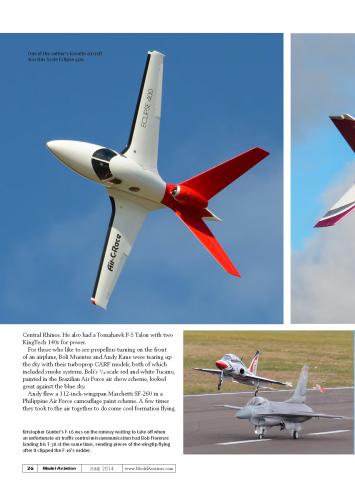March 5-8, 2014, was the date for one of the largest RC jet events in the world, which included jet aircraft of all types and sizes. It was held at the newly renovated Paradise Field, located at the Lakeland Airport in Lakeland, Florida.
I say newly renovated because it is located on the same property with a new 52-foot by 720-foot asphalt runway. There is also a 40-foot grass runway on the outside of the asphalt for those who prefer the grass. The area also allows much more room for vendors and parking. Event promoter Frank Tiano didn’t disappoint and this renovated venue is much better.
I arrived on Wednesday morning with cameras in hand, ready for a fantastic weekend of weather and flying. The model aircraft included everything from electric-powered ducted fans to turbines, as well as sport jets, civilian jets, and warbirds. Approximately 200 jets and 120 pilots were registered to fly.
The weather was nearly perfect with blue skies, occasional clouds, and 70° temperatures on Wednesday. Thursday brought a cold front through the area, but that didn’t stop people from flying that afternoon. It was slightly cooler and the winds were a little high on Friday. Saturday was again picture-perfect! Because this was a noncompetitive event, the open flying started at 8:30 a.m. and didn’t end until 5:30 p.m.
One model that caught my attention was Steve Stricker’s beautiful F-4 Phantom. This Skymaster 1/7.5-scale model is powered by a JetCat 180-RX and took roughly two years to complete. The attention to scale detail is fantastic, not to mention how realistically Steve flew it. He took home four awards with this airplane.
If you’re into sport jets, Pablo Fernandez of Elite Aerosports brought plenty of his Shockwave jets to entertain the crowd. At any given moment there was at least one Shockwave in the air flown by Pablo or another pilot. The Shockwaves weren’t hard to spot with their bright, unique paint schemes.
For those of you who like Scale models as much as I do, there were plenty of those as well. Bob Violett Models (BVM) had a big showing with its new line of plug-and-play 1/6-scale F-16s. With a 65.5-inch wingspan and a length of 96.5 inches, this model is the perfect size. It is available in six paint schemes.
One of the great things about the new runway is the quality of some of the photos I was able to capture, including the big F-100 flown by Ali Machinchy. Built by Norwegian Trond Hammerstad, this monster with its German paint scheme had a parachute that was released on touchdown, which made for some awesome photos.
This wasn’t the only monster jet at the event. Lucas “Lukey” Martinez brought his 1/6-scale Fly Eagle F-18 Super Hornet, powered by two Jet Central Rhinos. He also had a Tomahawk F-5 Talon with two KingTech 140s for power.
For those who like to see propellers turning on the front of an airplane, Boli Muentes and Andy Kane were tearing up the sky with their turboprop CARF models, both of which included smoke systems. Boli’s 1/4-scale red and white Tucano, painted in the Brazilian Air Force air show scheme, looked great against the blue sky.
Andy flew a 112-inch-wingspan Marchetti SF-260 in a Philippine Air Force camouflage paint scheme. A few times they took to the air together to do some cool formation flying.
Saturday’s Halftime Events
One of the highlights of Florida Jets each year is Saturday’s noon air show. This year’s show wasn’t as much of a flying show as it was a fun couple of events for the spectators. Frank decided to do something this year with balloons and small electric airplanes. A couple of months before the event, he announced to the pilots to bring small electric airplanes with them.
Frank’s staff released 75-100 balloons and the “big kids” (registered pilots) were then able to fly those electric airplanes into the balloons to try to pop them. After a few midair collisions and a few popped balloons, it was time for the “small kids” to come out and have some fun.
The field was cleared of all models except for a giant Telemaster JR Candy Machine (available from Hobby Express) with a 12-foot wingspan that flew over the runway for a special delivery. As the kids waited behind the pilot stations, the Telemaster released from its belly a few pounds of candy. The kids were then allowed to run out and fill their pockets. Needless to say, it took a while to get them back behind the spectator fence.
If you were hungry during all of this action, food vendors were onsite all day waiting to serve you. There were also vendors selling all types of merchandise from accessories to models.
Conclusion
One of the most enjoyable parts of the event was the Saturday night banquet and auction. During the banquet, 22 awards were given out while the guests enjoyed the buffet-style dinner. After the dinner was an auction of RC-related items from receivers to model kits. A disc jockey was on hand for those who wanted to do some dancing. It was a great way for the pilots to meet new people and hang out with friends.
The new asphalt runway was a hit with all of the pilots. There are already some more improvements being made such as expanding the pit area with 2,000 square feet of added concrete. I anticipate that next year’s Florida Jets will have a record attendance.
To receive updates about other scheduled events at the renovated venue and for more information and hundreds of photos, visit Frank Tiano’s website.










